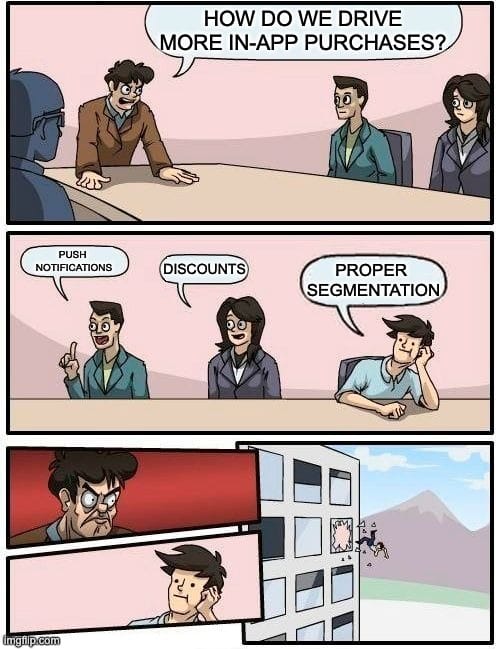Using User Segmentation to Drive In-App Purchases in Mobile Games

User segmentation is a crucial strategy in mobile game monetization, allowing developers to create targeted marketing and monetization efforts. By dividing the player base into distinct groups based on shared characteristics, developers can tailor in-game experiences and offers to meet specific needs.
User segmentation, at its core, involves analyzing player data to identify patterns and commonalities, which are then used to categorize users into meaningful segments. These segments can be based on various factors, such as demographics, in-game behavior, psychographics, or technological preferences. By understanding the unique needs, preferences, and motivations of each segment, game studios can deliver personalized experiences that resonate with their target audiences, and foster a deeper engagement, thus increasing the likelihood of in-app purchases. In this blog we will focus on how segmentation is used to drive in-app purchases (IAPs)and boost overall game revenue.
Different Types of User Segmentation in Mobile Games
Before we get into how to use segmentation to boost in-app purchases, let’s briefly go over the different types of user segmentation in mobile games. Here are some of the most common types of user segmentation:
Demographic Segmentation: This approach divides players based on demographic factors such as age, gender, location, and income level.
Behavioral Segmentation: This type of segmentation focuses on players' in-game actions, such as their progression through levels, frequency of play, in-app purchases, and engagement with specific game features.
Psychographic Segmentation: This approach segments players based on their interests, values, personalities, and lifestyles.
Technographic Segmentation: This method segments players based on their technological preferences, such as the devices they use, operating systems, or their affinity for cutting-edge technologies.
How User Segmentation Benefits Mobile Game Monetization

User segmentation offers numerous benefits for mobile game monetization, particularly when it comes to driving in-app purchases (IAPs). By understanding the motivations, behaviors, and preferences of different player segments, developers can create targeted offers and experiences that resonate with each group, increasing the likelihood of conversion.
One of the primary advantages of user segmentation is the ability to enhance player engagement and retention. When players feel that the game experience is tailored to their specific needs and interests, they are more likely to remain engaged and continue playing for longer periods. This increased engagement not only fosters a stronger emotional connection with the game but also creates more opportunities for monetization through IAPs.
Additionally, user segmentation allows developers to optimize their marketing efforts and advertising campaigns. By targeting specific segments with personalized messaging and offers, developers can maximize the effectiveness of their marketing spend, resulting in higher conversion rates and a better return on investment (ROI).
Steps to Implement Effective User Segmentation
Implementing an effective user segmentation strategy in mobile games requires a structured approach and a deep understanding of player data. Here are the key steps to follow:
- Data Collection: Gather relevant player data from various sources, such as in-game analytics, MMPs, user profiles, and third-party data providers. This data can include demographic information, traffic source, in-game behavior, purchase history, and device specifications.
- Data Analysis: Analyze the collected data to identify patterns, trends, and correlations that can inform the segmentation process.
- Segment Creation: Based on the insights gained from data analysis, define the criteria for creating meaningful player segments. These criteria should align with your business objectives and target specific behaviors, preferences, or characteristics.
- Segment Targeting: Once you have established your player segments, develop targeted marketing campaigns, in-game experiences, and IAP offers tailored to the unique needs and preferences of each segment.
- Regularly monitor the performance of your segmentation strategy and make data-driven adjustments as needed. Player behaviors and preferences can change over time, so it's essential to keep your segments up-to-date and relevant.
By following these steps, you can establish a robust user segmentation framework that supports data-driven decision-making and allows you to create highly personalized experiences that drive in-app purchases for overall game success.
Crafting Targeted In-App Purchase Offers Using Segmentation
One of the primary applications of user segmentation in mobile games is the creation of targeted in-app purchase (IAP) offers. By leveraging the insights gained from segmentation, PMs, and developers can craft personalized IAP offers that resonate with specific player segments, increasing the likelihood of conversion.
Here are some strategies for creating targeted IAP offers using user segmentation:
1. Segment-Specific Pricing:
Adjust IAP pricing based on player segments. For instance, players in regions with higher disposable incomes may be more receptive to premium pricing, while those in lower-income regions may respond better to more affordable offers.
2. Tailored Bundle Offerings:
Create IAP bundles tailored to the preferences and behaviors of specific segments. For example, players who frequently engage with social features may be interested in bundles that include virtual goods or accessories for enhancing their in-game social presence.
3. Personalized Promotions:
Develop targeted promotions and limited-time offers based on player segments. These can include discounts, bonus content, or exclusive virtual items that appeal to the unique interests and motivations of each segment.
4. Contextual IAP Placements:
Strategically place IAP offers within the game experience based on player segments. For instance, players who enjoy a particular game mode or character may be more receptive to IAP offers related to those elements.
5. Segment-Specific Messaging:
Craft IAP messaging and advertising copy that speaks directly to the needs, values, and preferences of each player segment. This can include tailored language, imagery, and value propositions that resonate with the target audience.
Enhancing User Experience Through Personalization
While user segmentation is a powerful tool for driving in-app purchases, its benefits extend beyond monetization. By leveraging segmentation data, developers can create highly personalized user experiences that cater to the unique needs and preferences of each player segment. Here are some ways in which personalization can enhance the user experience in mobile games:
1. Personalized Content and Features:
Tailor in-game content, such as levels, challenges, and narratives, to align with the interests and preferences of specific player segments. This can include offering different game modes, difficulty levels, or storylines based on player preferences.
2. Customized User Interfaces:
Adapt the user interface and navigation elements to suit the needs and behaviors of different player segments. For instance, players who prefer a more immersive experience may benefit from a streamlined UI, while those seeking social interaction may appreciate prominent social features and leaderboards.
3. Targeted Recommendations:
Leverage segmentation data to provide personalized recommendations for new games, in-game content, or virtual items that align with each player's interests and behaviors.
4. Tailored Onboarding and Tutorials:
Customize the onboarding experience and in-game tutorials based on player segments. For example, experienced players may prefer a more condensed tutorial, while new players may benefit from more detailed guidance and instructions.
5. Personalized Messaging and Notifications:
Craft in-game messages, push notifications, and promotional content that speaks directly to the interests and motivations of each player segment, enhancing relevance and engagement.
Analyzing and Optimizing Segmentation Strategies
Implementing an effective user segmentation strategy is an iterative process that requires continuous analysis and optimization. As player behaviors and preferences evolve, game studios need to adapt their segmentation approaches to ensure they remain relevant and effective. Here are some key considerations for analyzing and optimizing user segmentation strategies:
1. Performance Monitoring:
Regularly monitor the performance of your segmentation strategy by tracking key metrics such as engagement rates, retention rates, conversion rates, and revenue generated from each player segment. This data will provide insights into the effectiveness of your segmentation approach and help identify areas for improvement.
2. A/B Testing:
Conduct A/B tests to compare the performance of different segmentation strategies, IAP offers, or personalized experiences. This will allow you to make data-driven decisions and continuously refine your approach based on real-world performance data.
3. Segment Refinement:
As player behaviors and preferences evolve, it may be necessary to refine or adjust your existing player segments. Regularly review and update your segmentation criteria to ensure they remain relevant and accurately reflect the current state of your player base.
4. Predictive Modeling:
Leverage machine learning and predictive modeling techniques to anticipate player behavior and identify potential segments or trends before they emerge. This proactive approach can help you stay ahead of the curve and optimize your segmentation strategy accordingly.
5. Cross-Channel Integration:
Ensure that your user segmentation strategy is integrated across all channels, including in-game experiences, marketing campaigns, customer support, and analytics platforms. This holistic approach will provide a consistent and cohesive experience for players, regardless of their touchpoint with your game.
Case Studies: Successful Use of User Segmentation in Mobile Games
To illustrate the power of user segmentation in driving in-app purchases and overall game success, let's explore some real-world case studies of mobile games that have effectively implemented this strategy.
Clash of Clans (Supercell)
Supercell's hit mobile game, Clash of Clans, has leveraged user segmentation to create targeted in-app purchase offers and personalized experiences. By analyzing player behavior, the game identifies different segments, such as "whales" (high spenders), "dolphins" (moderate spenders), and "minnows" (non-spenders).
Based on these segments, Supercell crafts tailored IAP offers and bundles that cater to the specific needs and preferences of each group. For instance, whales may be offered exclusive virtual items or boosters at premium prices, while dolphins and minnows may receive more affordable bundles or limited-time discounts.
Additionally, Clash of Clans personalizes in-game content and features based on player segments. More experienced and engaged players may be offered more challenging game modes or exclusive events, while newer players may receive tailored tutorials and guidance to enhance their onboarding experience.
Pokémon GO (Niantic)
Niantic's augmented reality game, Pokémon GO, has effectively utilized user segmentation to drive in-app purchases and foster a vibrant player community. By analyzing player data, Niantic identifies segments based on factors such as location, playstyle (casual or hardcore), and engagement levels.
Based on these segments, Niantic offers targeted IAP offers and bundles. For example, players in urban areas may receive offers for virtual items or power-ups that enhance their gameplay experience in densely populated areas, while rural players may receive offers tailored to their specific gameplay challenges.
Additionally, Niantic personalizes in-game events and community activities based on player segments. Hardcore players may be invited to exclusive raids or challenges, while casual players may receive tailored in-game quests or social events to keep them engaged and connected with the broader Pokémon GO community.

Conclusion: Maximizing In-App Purchases with User Segmentation
User segmentation is a powerful tool for maximizing in-app purchases and overall game success. By understanding and categorizing players based on their characteristics and behaviors, developers can create targeted and personalized experiences that enhance engagement and drive revenue. Effective segmentation strategies lead to higher retention rates and increased player satisfaction, ultimately boosting the lifetime value of each player.
Implementing an effective user segmentation strategy requires a structured approach, involving data collection, analysis, segment creation, validation, and continuous monitoring and optimization. By following these steps, developers can establish a robust segmentation framework that supports data-driven decision-making and enables the creation of highly personalized in-app purchase offers, tailored bundle offerings, contextual IAP placements, and segment-specific messaging.
Furthermore, user segmentation extends beyond monetization, enabling developers to deliver personalized content, customized user interfaces, targeted recommendations, tailored onboarding experiences, and personalized messaging that fosters a deeper emotional connection with players, ultimately leading to increased engagement and retention.
Boost Your Game's IAPs with Segwise.ai
Are you ready to unlock the full potential of user segmentation and drive unprecedented in-app purchase growth for your mobile game? Segwise offers AI agents to do just that for you.
Our AI agents are specifically designed to analyze your player data, identify meaningful segments, and craft tailored in-app purchase offers that resonate with each group's unique preferences and behaviors. By leveraging advanced machine learning algorithms and predictive modeling techniques, Segwise.ai anticipates player behavior and proactively adapts your segmentation strategy, ensuring that you stay ahead of the curve and maximize revenue opportunities.
But that's not all – Segwise’s agents also root cause game metrics you deeply care about and find causal metric drivers, which allows you to jump on LiveOps opportunities faster.
Don't let the competition outpace you. Embrace the power of AI Agents for user segmentation and personalization with Segwise.ai, and unlock your full revenue potential.

Comments
Your comment has been submitted successfully!